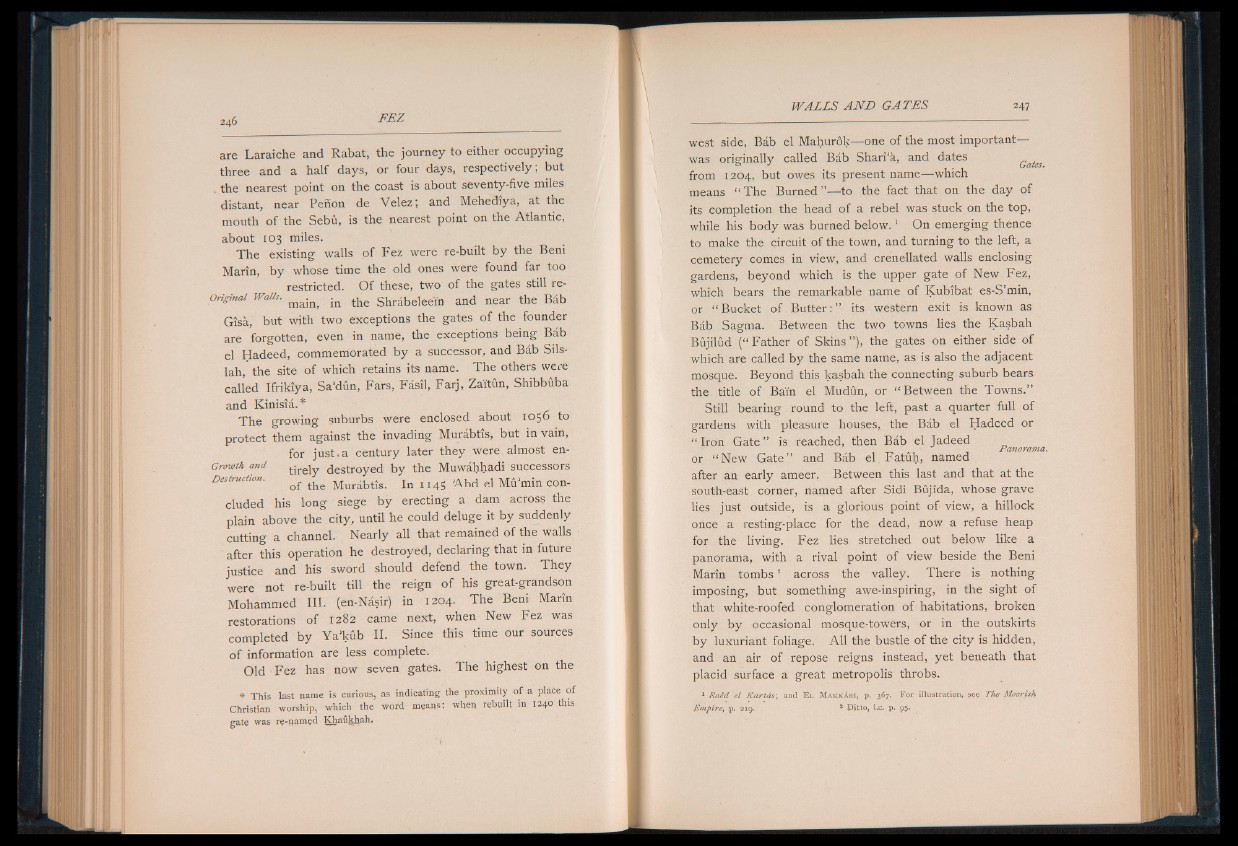
are Laraiche and Rabat, the journey to either occupying
three and a half days, or four days, respectively, but
the nearest point on the coast is about seventy-five miles
distant, near Peñón de Velez; and Mehediya, at the
mouth of the Sebü, is the nearest point on the Atlantic,
about 103 miles.
The existing walls of Fez were re-built by the Beni
Marin, by whose time the old ones were found far too
restricted. Of these, two of the gates still re-
OHginal Walls. in the Shrábeleeín and near the Báb
Gisa, but with two exceptions the gates of the founder
are forgotten, even in name, the exceptions being Báb
el Hadeed, commemorated by a successor, and Báb Sils-
lah, the site of which retains its name. The others were
called Ifrikiya, Sa’dün, Fars, Fásil, Farj, Zai'tün, Shibbüba
and Kinisíá.*
The growing suburbs were enclosed about 1056 to
protect them against the invading Murábtis, but in vain,
for ju s t.a century later they were, almost en-
Growth and. t¡rely destroyed by the Muwáhhadi successors
of the Murábtis. In 1145 ^A-bd el Mu’min concluded
his long siege by erecting a dam across the
plain above the city, until he could deluge it by suddenly
cutting a channel. Nearly all that remained of the walls
after this operation he destroyed, declaring that in future
justice and his sword should defend the town. They
were not re-built till the reign of his great-grandson
Mohammed III. (en-Násir) in 1204. The Beni Marín
restorations of 1282 came next, when New Fez was
completed by Ya'kub II. Since this time our sources
o f information are less complete.
Old Fez has now seven gates. The highest on the
* This last name is curious, as indicating the proximity of a place of
Christian worship, which the word means; when rebuilt m 1240 this
gate was re-named KhaukJjah,
west side, Bab el Mahurok— one of the most important—
was originally called Bab SharPa, and dates
from 1204, but owes its present name— which
means “ The Burned”— to the fact that on the day of
its completion the head of a rebel was stuck on the top,
while his body was burned below.1 On emerging thence
to make the circuit of the town, and turning to the left, a
cemetery comes in view, and crenellated walls enclosing
gardens, beyond which is the upper gate of New Fez,
which bears the remarkable name of Kubibat es-S’min,
or “ Bucket of Butte r;” its western exit is known as
Bab Sagma. Between the two towns lies the Kasbah
Bujilud (“ Father of Skins” ), the gates on either side of
which are called by the same name, as is also the adjacent
mosque. Beyond this kasbah the connecting suburb bears
the title of Bain el Mudun, or “ Between the Towns.”
Still bearing round to the left, past a quarter full of
gardens with pleasure houses, the Bab el Hadeed or
“ Iron G ate ” is reached, then Bab el Jadeed Panorama.
or “ New Gate” and Bab el Fatuh, named
after an early ameer. Between this last and that at the
south-east corner, named after Sidi Bujida, whose grave
lies just outside, is a glorious point o f view, a hillock
once a resting-place for the dead, now a refuse heap
for the living. Fez lies stretched out below like a
panorama, with a rival point of view beside the Beni
Marin tombs4 across the valley. There is nothing
imposing, but something awe-inspiring, in the sight of
that white-roofed conglomeration of habitations, broken
only by occasional mosque-towers, or in the outskirts
by luxuriant foliage. All the bustle of the city is hidden,
and an air of repose reigns instead, yet beneath that
placid surface a great metropolis throbs.